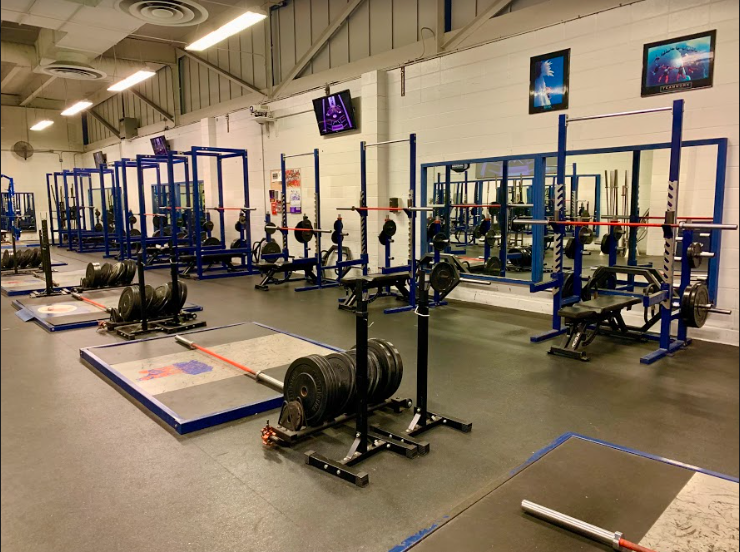Opinion: Let’s add a female-only strength and performance class to the new weight room proposal
Photo by Grace Ainger
Naperville North’s Strength and Performance (S&P) P.E. class has seen immense growth in its popularity over the last few years. Students have enjoyed the class’s supportive environment and the opportunity for daily weightlifting improvement. However, the sudden increase in student participation has created problems, one of the largest being space. With both S&P classes and sports teams using the space, the weight room is no longer an effective space for students.
According to NNHS Assistant Principal Jay Wachtel, Naperville North is actively working on a plan to expand part of the building, which would include additional space for a larger, updated weightroom. North’s goal is to have a space big enough to accommodate two classes or sport teams using the facility at the same time. An expanded weight room would allow more North students to participate in all the health benefits weightlifting has to offer, but one problem still remains.
Many female students have expressed frustration with the male-dominated S&P classes. They want to be involved and learn more about weightlifting, but don’t always feel comfortable in the current class environment. Senior Kendall Ingstrup explains how she initially wanted to take the class, but later changed her mind.
“I wanted to sign up for Strength and Performance my junior year…I felt relieved that I hadn’t chosen it because I knew that I would have felt really stressed out in that environment. So I’ve just worked out on my own a lot recently,” Ingstrup said.
Why do girls feel so intimidated when entering the S&P class? For one, it’s scientifically proven that males are often taller, faster and stronger than females. Princeton University’s Health and Fitness Coordinator Matt Brzycki studied the percentage differences between men’s and women’s strength. He found that “the absolute total-body strength of women has been reported as being roughly 67% that of men…so in absolute terms, men are much stronger than women.” In a weightlifting class, this physical difference creates an undeniably intimidating environment for female students, especially when they are significantly outnumbered by their male peers. Junior Naomi Marx, who’s currently taking the class, explains why the environment can be difficult for female students such as herself.
“It’s a very scary and intimidating environment for girls… the masculinity and guys trying to lift the heaviest weights possible [while] the music’s really loud. I’m in the corner with the other girls trying to get the workout done, but there’s all these other guys who are so rowdy and trying to be show offs,” Marx said.
In the current S&P class format, male students have a larger community to support their weightlifting goals, such as pushing for a heavier weight or learning how to use different machines. Female students are significantly outnumbered and therefore do not have that same community presence. In order for female students to have a more comfortable environment for achieving their weightlifting goals, a female-only Strength and Performance class must be implemented.
The purpose of the S&P class is to provide students with an opportunity to learn from and improve alongside their peers and teachers. S&P has been a great experience for many who have taken the class, but some female students have struggled to find the necessary community to support them in the male-dominanted environment. Instrup elaborates on how the S&P dynamic can be discouraging for a female who is less knowledgeable about weightlifting.
“You have this pressure to not look like a fool like you don’t know what you’re doing. When you first start, you need a community… [so] you don’t feel alone or intimidated in that environment that’s full of people that have been working out for years,” Ingstrup said.
Adding a female-only class would provide a space for those who are less knowledgeable about weightlifting to learn from peers as comfortably and confidently as male students have been able to do. It would greatly improve the encouraging and supportive nature of the class for males and females alike.
With a class as popular as S&P, some may think that adding a female-only class may take space away from a coed class. If the expansion is carried out, two coed classes likely would be able to workout in the same period, which would shrink the amount of periods needed for the class and allow space for a female-only class in a free period.
If the new weight room is created, adding a female-only Strength and Performance class would allow for female and male students alike to workout in the environment they feel most comfortable in, resulting in the further encouragement of Naperville North students to continue improving their physical fitness and quality of life.
“Strength and Performance should be a safe place for all people to weightlift and to feel like they can improve their physical abilities,” Marx said.

Grace is a senior at North and is thrilled to begin her second year of The North Star as Managing Editor. She’s excited to pursue her own journalistic...











